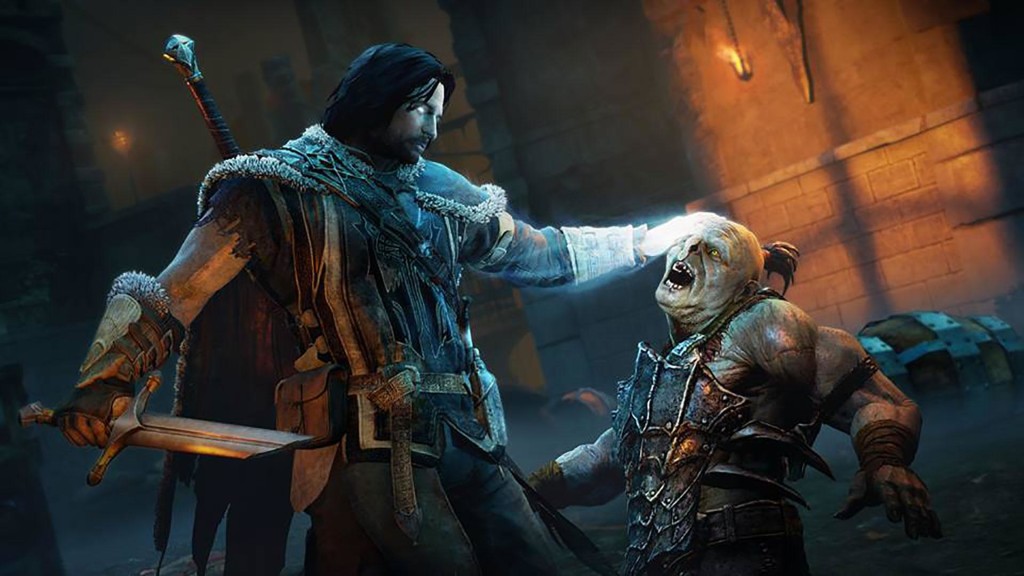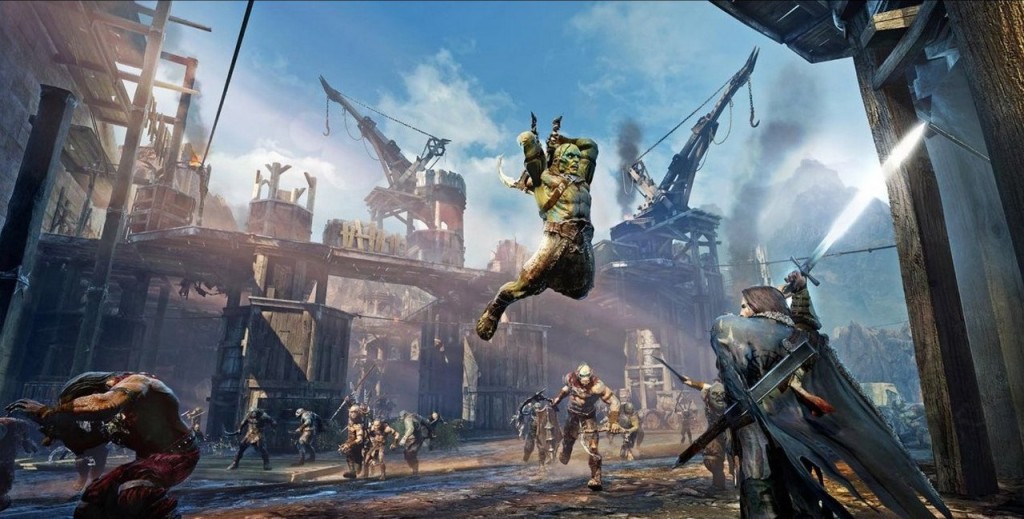Shadow of Mordor is a strange game to play after finishing Metal Gear Solid V. In some ways, it copies all the things I hate out of modern open-world AAA action games (quite a mouthful!) – Assassin’s Creed’s horrible movement controls and its bounty of collectibles, Batman and its “rhythmic” combat system with aerial “stealth” bits, and probably a litany of other open world trends I either missed or equally disliked. Yet, Shadow of Mordor never fails to entertain me, and that comes down to one fundamental reason: focus.
Monolith’s latest (at least circa 2014) isn’t trying to sell a convincing portrayal of the Italian renaissance, nor trying to put you into the role of Batman. In fact, the Lord of the Rings license seems rather ephemeral to the actual “good” parts of the game. Sure, it copies Peter Jackson’s trilogy on a number of aesthetic notes, not the least of which is Gollum, but it does this purely to emulate the brutality of the film’s action. Shadow of Mordor would rather make a delightful interplay of combat and fighting systems revolving around evolving foes, known as THE NEMESIS SYSTEM, and the game makes full use of this strangely named idea throughout.
Assume that Mordor’s various Uruk-hai and Orcs have a sort of “hierarchy”. Sauron commands some dumb brutes, but they do need commanders to put them in rank and file. However, Sauron’s minions are a petty squabbling lot who always look to get ahead and “get promoted”, as it were, so they often fight each other. Shadow of Mordor present you with a literal chart that shows you this command structure – who commands and controls which officer orcs (shorthand for all of them just for my sanity). Kill an orc, and another will be promoted to take his place; get kill by an orc, and he’ll rise in stature since he killed you and deserves it! Every time you die, run away, or kill an orc, you shuffle the structure of Sauron’s army accordingly, for good or ill.
This sounds terribly boring, and in a sense it is; Monolith decided the best way to show this lie in an abstract menu screen, rather than using the open world to their advantage. The Nemesis System seems like a net gain all around, though; your actions have actual consequences. Repeated deaths can strengthen a foe beyond your current abilities, and cause him to chase you looking for a free kill. Orcs dynamically remember your previous encounters, showing scars and injuries from your previous battle (as long as they aren’t decapitated, orcs are surprisingly sturdy). You can interfere in orc duels and fights, choosing your personal favorite orc to work up the ranks. The dynamic generation of this content tends to make fights much more interesting, since orcs will surprise you out of nowhere when you’re trying to complete missions!
Of course, it does get more interesting as things go along. I’m not sure why the game restricts the Branding ability to the last half of the game, but it really takes advantage of the Nemesis System. Due to special plot-related abilities, you can convert orcs to your side and create an orc army. That doesn’t just apply to normal grunts, but also to officers and warchiefs. Thus, in a way, you can manipulate the system to place your guys in charge by branding the warchiefs directly, or guiding a pet orc through duels and power struggles until he eventually becomes warchief. It’s like a real-time version of political manipulation and coercion, except you can actually use weapons instead of words! This leads to dynamic, interesting content, and motivation to kill/brand orcs in unique ways that, otherwise, would not exist.
This encourages you to get intelligence on the orc captains, too – you don’t want to promote dumb idiots who are afraid of caragors, for instance. So you find the best candidate, work him up the ranks, and then see the fruits of your labor as you take control of an entire political system. That also plays into the combat approach as well, since you want to plan your assault to kill/brand an officer. Each one has various strengths, weaknesses, and immunities that you’ll want to know before you set off the alarm or get yourself killed. The stealth is nothing special, copying the Book of Arkham straight, but branding archers and ranged enemies in advance can prove useful for your assault.
Because of violence being your primary language mode in a world of idiot monsters, Monolith did a great job making combat the ultimate focus of Shadow of Mordor, and it poses a mighty challenge due to all these surrounding elements. Most officers you need to kill or brand in the story come with 1-4 officer bodyguards a piece, meaning you either 1. want to plan in advance by using various traps in the bases 2. fight them head on (usually suicide, unless you’re crazy like me) or 3. brand an officer or two, get them to climb up the ranks and kill them for you with your aid from above. There’s a surprising amount of planning that can happen if you choose to do so. The combat works just as well as Arkham’s combat, with plenty more options and the necessity of dodging. Executions aren’t very easy, meaning you need to be constantly aware; dying happens a lot if you don’t know when to make a run for it. I like the stiff challenge, especially if you don’t upgrade very much, and that made the experience much more engaging for me. Uninterrupted combos prove tough, but you need them for your best abilities, and the game doesn’t hand it to you. The system by which you actually take advantage of the Nemesis System are, simply put, excellent. Other than wonky auto-targeting (seriously, can we just have lock-on already?! I didn’t want to stealth kill THAT guy), the overall stealth/combat mix takes the good parts of Batman and Assassin’s Creed.
All of this makes Shadow of Mordor engaging. It has a central objective, combat all the things via this elaborate framework, and when it works it’s brilliant. Or, at the very least, you would hope it works that way in practice. I imagine your grasp on Sauron’s armies aren’t permanent, since it seems as if the system operates without you most of the time. Further, you never actually need to interact with the system except for a few key spots which require you to kill or brand all the warchiefs to proceed with the story missions. I think of it like a violent, focused open world sandbox more than a “game”. As well, the plot…is the plot. People flit in and out of the story while disappearing forever, and I guess there’s revenge or something? Honestly, your main character is a block of wood who obviously was meant to evoke Boromir or Aragorn to a tee, and in that sense they succeeded. In telling a compelling story? Not so much.
As well, there’s an elaborate, and also bizarrely abstract, upgrade system. Unfortunately, they copy the Arkham series here, and not to great effect. Why so many upgrade trees? We’ve got one for normal statistics and weapons, runes for weapons, and also an ability tree based on how many orcs officers you best/kill/control. The weapon runes are the worst, with boring bonuses and percentage chance nonsense that tells you nothing (you get those weapon runes from orc kills, mostly, and they drop at random – this is dumb). The regular upgrade tree gives you TONS of combat options, which I appreciate. Still, at a point, they make the game unbelievably easy if you keep upgrading, so I tended to ignore power struggles as much as possible to avoid lessening the difficulty. Honestly, writing about this system you’ve seen in dozens of games puts me to sleep, so I won’t bother you any further with it.
Also, Shadow of Mordor does suffer from the collect-a-thon open world model in some respects; at least all of said challenges, goodies, and whatsits focus on upgrading your character only, so they do provide actual incentives for those who want to obtain them. If the game feels too hard, this is a nice way to alleviate some of that difficulty (especially health upgrades!). Mordor’s two areas in-game are also rather small, which helps for game purposes but not for a sense of “open world”. Talion also suffers from janky movement controls, much like Assassin’s Creed; you will get stuck on walls and knee-high rocks, and your character just stops moving for no reason due to bad collision detection. I suppose that’s just natural at this point, so I just roll with it.
Even disparate parts need some structure and assembly. Somehow, I didn’t think I’d enjoy another game of this type, but the Nemesis System really takes the cake by providing a focused approach for all of this stuff packed into the game. Without it, you’d be looking at an Assassin’s Creed III, but it’s clear that the framing device for this open world combat game actually provided some great benefits to the overall design. Heck, who’d expect that from a Lord of the Rings game, really? Even the Bible tells you a focused approach can help you out:
Let your eyes look directly ahead
And let your [i]gaze be fixed straight in front of you.
26 Watch the path of your feet
And all your ways will be established.
27 Do not turn to the right nor to the left;
Turn your foot from evil.– Proverbs 4
All in all, then, Shadow of Mordor surprised me by being engaging…but only as far as it takes to finish the game. As it is, its focused approach functioned quite well, but needed some additional push to be truly compelling. I’d say the rating above lies more in the 3.5 star range, but I gave the game the benefit of the doubt, given that I enjoyed my time with it.



